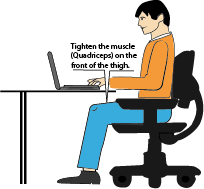Knee pain Simple must-do exercises
View(s):There are many causes of pain in the knee, though the majority of these pains are of mechanical origin and not due either to infection or malignancy.
 I would like to recommend a simple exercise which in my opinion is helpful, whatever other treatments you may be taking, for this common knee problem, often referred to as ‘osteoarthritis’.
I would like to recommend a simple exercise which in my opinion is helpful, whatever other treatments you may be taking, for this common knee problem, often referred to as ‘osteoarthritis’.
Rationale of the exercise:
The knees are constantly subject to the stresses and strains of weight bearing when standing and walking. These stresses are increased when climbing stairs or slopes or coming down the same. In fact , while you might feel that it should be easier to come down the stairs than climb them, the reverse is the case.
When we stand up, what prevents us buckling at the knees and falling down, as a result of the action of gravity, is the strong muscle on the front of the thigh (the quadriceps), which is contracted strongly to prevent our knees bending. When we straighten out a bent knee the muscle that performs this action is this strong muscle. The quadriceps muscles are the most powerful muscles giving support to the knee. They form strong, active splints which keep the knees straight and help greatly in maintaining the standing posture. When negotiating steps or slopes these muscles contract more forcibly, the contractions being greater when going down than when climbing up.
If you have pain in the knee the quadriceps tends to weaken and get thinner, so that the support to the knee is reduced. As a result, although the knee may not actually buckle under you, every time you bear weight on the limb the knee joint tends to bend ever so slightly, unnoticed by you. So the knee joints are constantly subjected to tiny ‘shocks’ which can only aggravate the mechanical problem you have.
 It is very essential to prevent the powerful quadriceps from weakening and wasting whatever the cause of a painful knee. The strength and bulk of this muscle is maintained by doing quadriceps exercises.
It is very essential to prevent the powerful quadriceps from weakening and wasting whatever the cause of a painful knee. The strength and bulk of this muscle is maintained by doing quadriceps exercises.
The Quadriceps Exercise:
This exercise can be done both when lying in bed and when seated.
Before getting out of bed in the morning:
With your knee straight, straighten it to the maximum so that the back of the knee is pressed firmly against the bed. To do this you have to tighten the muscle (quadriceps) on the front of the thigh. (If you tighten this
muscle effectively; you can feel and see the muscle tighten; you will not be able to move the knee-cap from side to side.)
With the muscle firmly contracted, count 5.
Now keeping the knee straight, raise the leg slowly off the bed through an arc of about 60 degrees.
Bend the knee and straighten it out again.
Bring the leg down to the starting position.
Repeat the same, as described above, with the other leg.
When you have exercised both limbs as described the exercise has been done once.
Repeat the above (on both sides),on the first day 5 times, and gradually work up to 10 times.
The exercise while seated:
Sit on the chair, preferably a chair with arm rests. Keep your trunk at right angles to your thighs and bend your knees to a right angle.
Now plant your feet firmly on the ground and attempt to stand without actually doing so. If you chair has arm rests press down on them with elbows bent. You will feel and see the thigh muscles getting firmer (contracting).
Hold the contracted position for a count of 5 and relax.
Repeat 5 to 10 times.
This exercise can be done without anyone noticing that you are exercising! You can do it while seated at the computer, or at your desk or at the dining table.
The more often you do this exercise the stronger your quadriceps will be and the more support and protection your knees will have. Start slowly and gradually increase the number of times you do the exercise, but always stop short of developing pain while doing the exercise.
The success of this regime depends on your doing the exercise regularly, whether you have pain or not. Once you start, it’s a life-time exercise. It prevents recurrence of a pain that has left you and also prevents aggravation of the mechanical problem responsible for the pain. Furthermore, it delays the onset of knee pain which many people tend to get as they get along. I like to think of this problem as ‘shock-absorber problem’!
One last bit of advice. When sitting, particularly squatting, do so slowly and smoothly. When straightening up do so in a similar fashion.
The reason for this is that when moving from the straight knee to the bent knee position, while bearing weight or when straightening out from the bent position, the thigh bone turns on the leg bone with a grinding motion. By doing the movement slowly and smoothly the stresses on the knee joints are reduced.
(The writer is former Orthopaedic Surgeon, General Hospital, Kandy)


